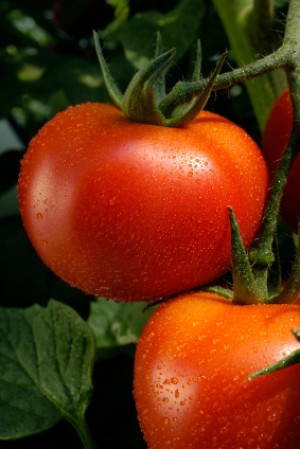
Tomatoes are America's most popular garden crop, but they are not necessarily the easiest crop to grow. Even the most experienced gardeners occasionally find themselves at a loss as to why their tomato plants fail. Here are a few helpful guidelines for understanding tomatoes. The more you know about their needs and growth habits, the easier it will be to cope with their sometimes puzzling behavior.
Tomato plants have a heavy workload, so their soil needs to provide them with a good supply of nutrients. To produce a crop of fruit successfully, they require moderate levels of nitrogen and phosphorus and moderate to high levels of potassium and calcium. Before planting seedlings, mix 1 cup of kelp meal and 1 cup of bone meal into the bottom of the planting hole. This will provide your plants with the necessary potassium and phosphorus. As long as you are starting with good soil, no additional feeding should be necessary until fruit is set.
Once fruit is set, feed plants monthly with an organic fertilizer that is low in nitrogen and high in phosphorus and medium to high in potassium. If your plants are starting out in poor soil, water your plants weekly with 1 cup of a fish emulsion solution (1 Tbsp. fish emulsion per gallon of water). Continue this from planting until the first blossoms form.
In the early stages of growth, before fruit has set, it is a good idea to put the plant under slight stress by stretching out the length of time between watering. After fruit has set, however, it's important to maintain uniform soil moisture. Fluctuating wet and dry spells can bring on stunting of plants, blossom-end rot and a host of other problems.
Once the weather warms up, plant your main season varieties. Row covers can also provide a bit of protection from weather that is too cold. Use them in the spring until the weather warms up.
When temperatures rise above 86 degrees F and the sun is at its most intense, fruit that is exposed to direct sunlight can fail to develop good, even red color. In climates where high summer temperatures are the norm, try to select varieties known for having a good dense foliage cover that will help protect developing fruit.
Tomato problems are usually caused by nutrient deficiencies, viruses, fungi, or insects. Some tomato varieties are more resistant to problems than others, and as always, good cultural practices can go a long way in reducing or eliminating many problems.
Late blight appears as dark green or brown patches on leaves and stems. Gray fuzz may appear on the undersides of leaves, while the stem ends of the fruit develop slimy brown patches.
The best ways to avoid tomato problems is to follow good cultural practices and start with disease-resistant plants. In catalogs and on plant tags, initials given after the variety name indicates kinds of resistance. Double initials indicate resistance to more than one strain of that type of disease.
V = verticillium wilt; F = fusarium wilt; T = tobacco mosaic virus; A = alternaria (early blight).